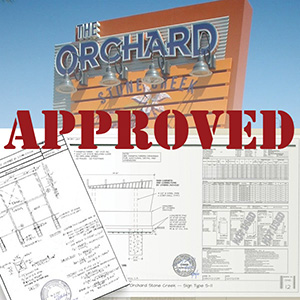8 tips for getting your shopping center sign approved.
By David Goodwin
When I started in the commercial signage business 27 years ago, we could walk into a city or county permitting office and, 15 minutes later, leave with an approved sign permit.
These days, if you choose to wait, you’ll be sitting in that same office for about 5 weeks on average.
The most challenging part of the signage industry isn’t in the design, fabrication or construction — it has long been the permitting process and managing bureaucracy. Regulations have become more challenging, establishing overall height, setbacks from the street and nearby structures, square footage allowances for text, distance between signs, and the number of signs that a property is allowed to have.
Rules and regulations — which vary depending on whether it’s a commercial, industrial or residential zone — are done in the name of keeping a pleasant aesthetic to streetscapes and skylines (although beauty is in the eye of the beholder) and, perhaps more nobly, ensures displays don’t impede right of way and keeps people safe (which we support).
 In an otherwise two-party, commercial transaction between sign designer/installer and property, the involvement of government bureaucracy can quickly slow down business. And sometimes, these stringent regulations can kill a project altogether.
In an otherwise two-party, commercial transaction between sign designer/installer and property, the involvement of government bureaucracy can quickly slow down business. And sometimes, these stringent regulations can kill a project altogether.
Here are eight tips I’ve learned over the years to get through it as fast as possible and keep your project on track.
Never Walk Into a Permitting Office Blind
If you are going into the permitting process for first time, do your homework to understand the true nuances of the code up front, or call by phone and discuss them before you step foot in the office. It is critical to know precisely what you can and can’t do with your location’s signage as early as possible.
Don’t Believe What You Read Online
Just because the ordinances and codes are listed online does not mean they are up to date. There also may be regulations at the property level, called proffers, that pertain to your property alone. These proffers may work for or against you; for example, an amendment to the code may have been granted to the original property owner to allow for signage that is taller or allows for more text space than code dictates.
Many Parties are Involved. Be Patient.
Years ago, a permitting office would quickly approve your design. If it met the requirements, you were good to go. Today, properties face much heavier scrutiny. Many require review from the local architectural review board. Some need a stamped engineer’s drawing. Other county officials want to see the calculations used by the engineer (whose job is on the line) to ensure they are accurate. We’ve also seen some jurisdictions getting second opinions from outside consultants before giving the green light.
Go Overboard on Information
Permit applications request a host of information — go above and beyond. Take pictures, provide renderings, even show communications between property managers and sign vendors. Dimensions will be requested; include your math. More information will give the approving bodies confidence that you’ve done your homework.
Build Relationships
Zoning rules are not always black and white; in the gray area are the relationships that you personally and professionally maintain with the individuals who are responsible for approving and rejecting signs. That doesn’t mean city or county employees need to have been lifelong friends; a pleasant “How’s your day going?” to the receptionist can get the process going on the right foot.
Relationships are equally as important with your neighbors, particularly if you are adding a digital LED display, which some may find intrusive. Make sure some of the more prominent voices nearby won’t challenge your new design with the permitting office. A neighbor’s letter of recommendation for your new sign could help move your permit through the process faster, too.
Follow Up and Be Persistent
Getting your sign is urgent for you; for the individuals responsible for getting it approved, you are one in a stack of to-dos. Be diligent and proactive. If they say they need a week to get back to you, call back in 3 days.
Look for Loopholes
In one county where we regularly install signs, the code says a sign cannot be more than 24 inches in depth, which means we can’t very well pull off dimensional layering. Reading closer, we found that the depth requirement did not apply if the sign has a V-shape, so we constructed a V-shaped sign to add more depth and layers.
Ask a Lot of Questions
Even if the rules seem crystal clear, ask lots of questions. It’s rather remarkable how some localities bend the rules — or don’t enforce them. Many signage requirements come about because someone in the course of the county’s history whined, someone in the county obliged, the zoning board passed the rule, and an obscure ordinance came to pass. That doesn’t mean these rules are enforced, though.
Some localities even prohibit pylons from including tenant names on them, but guess what? These localities (not naming names!) have numerous pylons filled with tenant listings. Those sign builders clearly did their research.
— David Goodwin is the president of Ad Vice Studios, a Richmond, Va.-based marketing services company best known for producing award-winning signage. Goodwin works with property managers, developers and architects to transform commercial properties into attractive destinations with unique brands and customer experiences. For more information, visit www.advicestudios.com.
